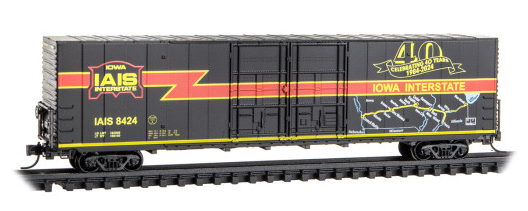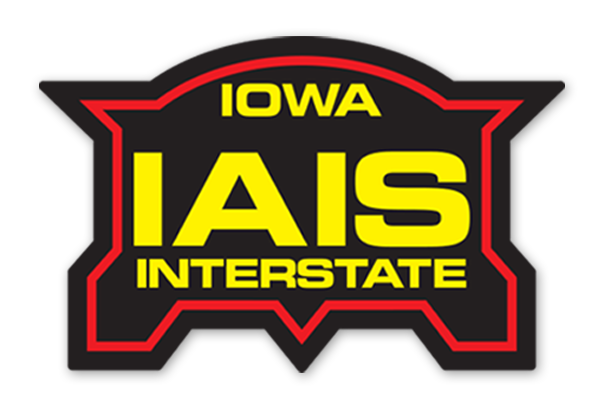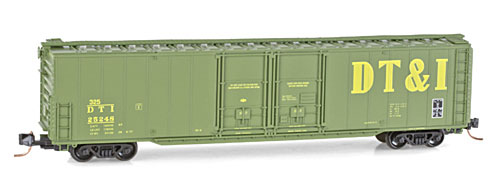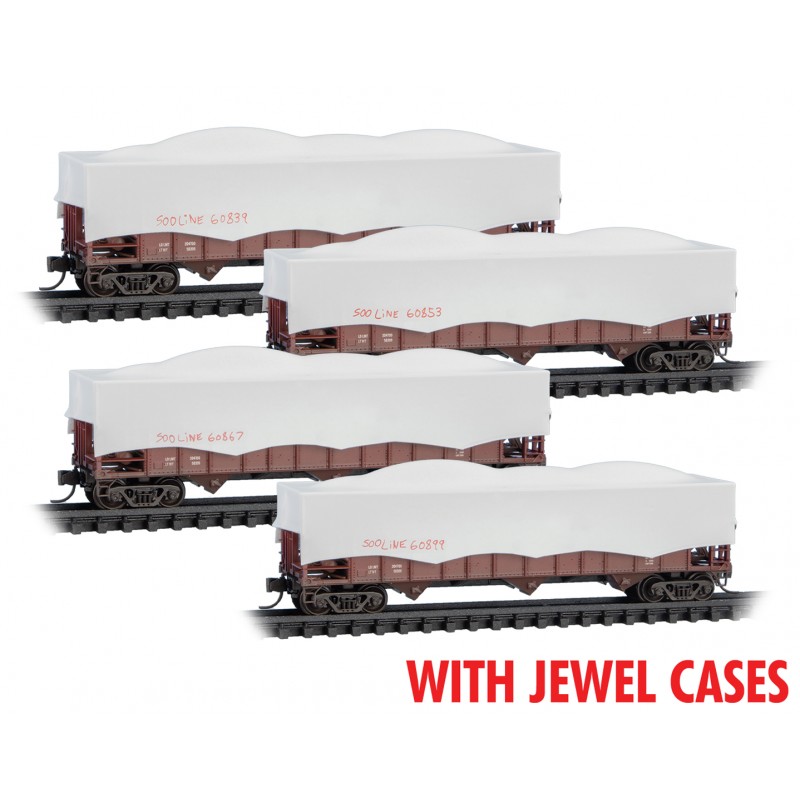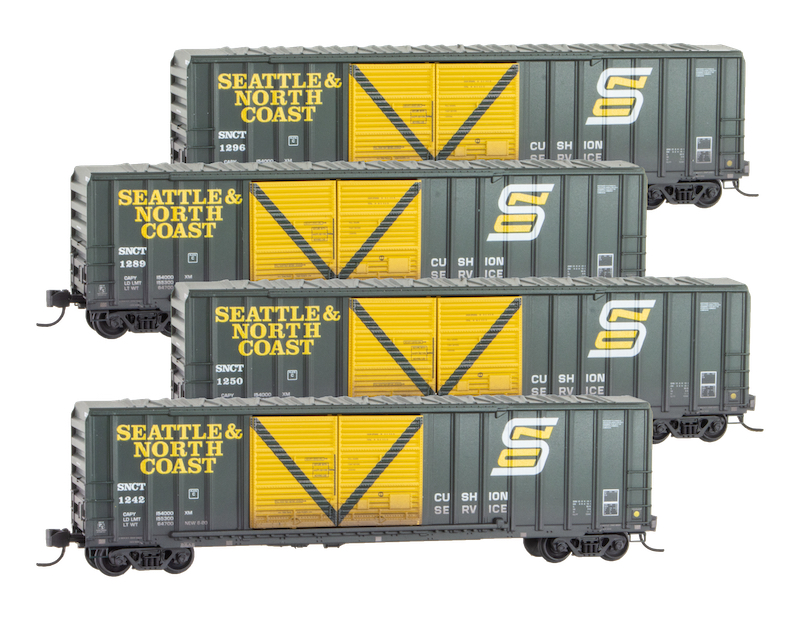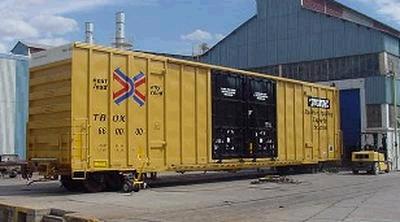Specific Item Information:
The Iowa Interstate Railroad is a Class II railroad that is headquartered in Cedar Rapids, Iowa. Founded in 1984, it operates over 580 miles across former Rock Island trackage through Iowa and Illinois, from Council Bluffs to the outskirts of Chicago. The IAIS is the only regional railroad that has interchange connections to every Class I railroad. In 2024, it is celebrating 40 years of operation.
The Iowa Interstate Railroad is a Class II railroad that is headquartered in Cedar Rapids, Iowa. Founded in 1984, it operates over 580 miles across former Rock Island trackage through Iowa and Illinois, from Council Bluffs to the outskirts of Chicago. The IAIS is the only regional railroad that has interchange connections to every Class I railroad. In 2024, it is celebrating 40 years of operation.
Model Information: This body style models a Boxcar, 60 Foot, Riveted Side, Double Plug Door, High Cube.
Prototype History: The modern 100 ton, high-cube, 60’ boxcar has become ubiquitous in the modern rail scene. These cars are designed to carry a myriad of loads, from auto parts to forest products. This 60 foot box car design was produced by Gunderson, Incorporated, now part of the Greenbrier Companies from the early 1970s into the 2000s.
60’ Heavy Duty Plate C Boxcar:
Designed for the can manufacturing industry, this 100-ton boxcar has two heavy-duty movable bulkheads and one standard moveable bulkhead for convenient loading of aluminum stock. Other features include end-of-car cushioning and 80,000-pound smooth steel flooring. All door type configurations are available.
60’ High Cube Plate E Boxcar:
This 100-ton boxcar has smooth interior walls with recessed lading strap anchors. Extra strength at the side-to-floor connections and the door frame makes this an ideal car for loading and unloading heavy paper rolls. All door type configurations are available.
60’ High Cube Plate F Boxcar - Auto Parts:
Designed for the auto parts industry, this 100-ton boxcar has 18-inch end-of-car cushioning, removable rub rails and a volume of 7,580 cubic feet, making it ideal for carrying auto parts and other high-volume products. All door type configurations are available.
60’ High Cube Plate F Boxcar - Forest Products:
Greenbrier designed and built this 100-ton boxcar with 15-inch end-of-car cushioning and removable rub rails for carrying forest products. All door type configurations are available.
60’ Heavy Duty Plate C Boxcar:
Designed for the can manufacturing industry, this 100-ton boxcar has two heavy-duty movable bulkheads and one standard moveable bulkhead for convenient loading of aluminum stock. Other features include end-of-car cushioning and 80,000-pound smooth steel flooring. All door type configurations are available.
60’ High Cube Plate E Boxcar:
This 100-ton boxcar has smooth interior walls with recessed lading strap anchors. Extra strength at the side-to-floor connections and the door frame makes this an ideal car for loading and unloading heavy paper rolls. All door type configurations are available.
60’ High Cube Plate F Boxcar - Auto Parts:
Designed for the auto parts industry, this 100-ton boxcar has 18-inch end-of-car cushioning, removable rub rails and a volume of 7,580 cubic feet, making it ideal for carrying auto parts and other high-volume products. All door type configurations are available.
60’ High Cube Plate F Boxcar - Forest Products:
Greenbrier designed and built this 100-ton boxcar with 15-inch end-of-car cushioning and removable rub rails for carrying forest products. All door type configurations are available.
Road Name History: The Iowa Interstate launched in 1984 to operate the former Rock Island mainline from Chicago to Omaha with a few short branches, and one longer branch to Peoria. The mainline also serves the Quad Cities and Des Moines along the way. Cedar Rapids is served by agreement with Cedar Rapids & Iowa City. This Rock Island route had been operated by the Iowa Railroad between 1981 and the establishment of the IAIS in ‘84. Chicago to Bureau is on trackage rights and the western terminal is actually in Council Bluffs with Omaha just over the state line. In total, the system is 580 miles. IAIS’s parent company is Railroad Development Corp.
Early operations were mostly handled by the usual spin-off suspects, rebuilt first generation EMD road switchers. Of the 36 engines, only 3 GP38’s and an Alco RS-36 were 2nd generation units. As traffic picked up over the years, they began to dump the first generation road switchers in favor of used 4 axle 2nd generation power. Now many of those have been returned and Iowa Interstate is going ultra-modern. As of this writing, their 44 engine fleet consists of: 12 ES44AC “GEVO”’s; 8 SD38-2’s; 22 GP38-2’s 1 GP38; and a pair of slugs.
They also have a pair of Chinese built 2-10-2 steam locomotives used for tourists and special events. They can also be found in freight service to break them in after shopping.
The addition of the 12 brand new GEVO’s permitted IAIS to retire twice that number of older 2nd generation road switchers, and still have a net increase of pulling power. Two of these GEVO’s wear Rock Island heritage colors.
In addition to the usual Midwestern mixed-manifest freights, IAIS has a respectable intermodal business. In the early years, this consisted of a single 5-unit Twinstack behind a GP9 (really!) As of this writing, IAIS sports its own fleet of Maxi-IV stack cars among others, and trailers and containers now move in sizable blocks.
Early operations were mostly handled by the usual spin-off suspects, rebuilt first generation EMD road switchers. Of the 36 engines, only 3 GP38’s and an Alco RS-36 were 2nd generation units. As traffic picked up over the years, they began to dump the first generation road switchers in favor of used 4 axle 2nd generation power. Now many of those have been returned and Iowa Interstate is going ultra-modern. As of this writing, their 44 engine fleet consists of: 12 ES44AC “GEVO”’s; 8 SD38-2’s; 22 GP38-2’s 1 GP38; and a pair of slugs.
They also have a pair of Chinese built 2-10-2 steam locomotives used for tourists and special events. They can also be found in freight service to break them in after shopping.
The addition of the 12 brand new GEVO’s permitted IAIS to retire twice that number of older 2nd generation road switchers, and still have a net increase of pulling power. Two of these GEVO’s wear Rock Island heritage colors.
In addition to the usual Midwestern mixed-manifest freights, IAIS has a respectable intermodal business. In the early years, this consisted of a single 5-unit Twinstack behind a GP9 (really!) As of this writing, IAIS sports its own fleet of Maxi-IV stack cars among others, and trailers and containers now move in sizable blocks.
Brand/Importer Information: Micro-Trains is the brand name used by both Kadee Quality Products and Micro-Trains Line. For a history of the relationship between the brand and the two companies, please consult our Micro-Trains Collector's Guide.
Manufacturer Information:  Micro-Trains Line split off from Kadee Quality Products in 1990. Kadee Quality Products originally got involved in N-Scale by producing a scaled-down version of their successful HO Magne-Matic knuckle coupler system. This coupler was superior to the ubiquitous 'Rapido' style coupler due to two primary factors: superior realistic appearance and the ability to automatically uncouple when stopped over a magnet embedded in a section of track. The success of these couplers in N-Scale quickly translated to the production of trucks, wheels and in 1972 a release of ready-to-run box cars.
Micro-Trains Line split off from Kadee Quality Products in 1990. Kadee Quality Products originally got involved in N-Scale by producing a scaled-down version of their successful HO Magne-Matic knuckle coupler system. This coupler was superior to the ubiquitous 'Rapido' style coupler due to two primary factors: superior realistic appearance and the ability to automatically uncouple when stopped over a magnet embedded in a section of track. The success of these couplers in N-Scale quickly translated to the production of trucks, wheels and in 1972 a release of ready-to-run box cars.
Micro-Trains Line Co. split off from Kadee in 1990 to form a completely independent company. For this reason, products from this company can appear with labels from both enterprises. Due to the nature of production idiosyncrasies and various random factors, the rolling stock from Micro-Trains can have all sorts of interesting variations in both their packaging as well as the products themselves. When acquiring an MTL product it is very important to understand these important production variations that can greatly enhance (or decrease) the value of your purchase.
Please consult our Micro-Trains Collector's Guide

Micro-Trains Line Co. split off from Kadee in 1990 to form a completely independent company. For this reason, products from this company can appear with labels from both enterprises. Due to the nature of production idiosyncrasies and various random factors, the rolling stock from Micro-Trains can have all sorts of interesting variations in both their packaging as well as the products themselves. When acquiring an MTL product it is very important to understand these important production variations that can greatly enhance (or decrease) the value of your purchase.
Please consult our Micro-Trains Collector's Guide
Item created by: Powderman on 2024-01-13 09:45:10. Last edited by grothe77 on 2024-07-16 17:54:38
If you see errors or missing data in this entry, please feel free to log in and edit it. Anyone with a Gmail account can log in instantly.
If you see errors or missing data in this entry, please feel free to log in and edit it. Anyone with a Gmail account can log in instantly.


